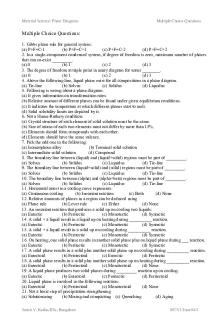MCQ m7 PDF

| Title | MCQ m7 |
|---|---|
| Author | Anonymous User |
| Course | Mehcanical engineering |
| Institution | Rajiv Gandhi University of Knowledge and Technologies |
| Pages | 3 |
| File Size | 98.2 KB |
| File Type | |
| Total Downloads | 48 |
| Total Views | 149 |
Summary
nice...
Description
Material Science/ Phase Diagrams
Multiple Choice Questions
Multiple Choice Questions: 1. Gibbs phase rule for general system: (a) P+F=C-1 (b) P+F=C+1 (c) P+F=C-2 (d) P+F=C+2 2. In a single-component condensed system, if degree of freedom is zero, maximum number of phases that can co-exist _________. (a) 0 (b) 1 (c) 2 (d) 3 3. The degree of freedom at triple point in unary diagram for water ________. (a) 0 (b) 1 (c) 2 (d) 3 4. Above the following line, liquid phase exist for all compositions in a phase diagram. (a) Tie-line (b) Solvus (c) Solidus (d) Liquidus 5. Following is wrong about a phase diagram. (a) It gives information on transformation rates. (b) Relative amount of different phases can be found under given equilibrium conditions. (c) It indicates the temperature at which different phases start to melt. (d) Solid solubility limits are depicted by it. 6. Not a Hume-Ruthery condition: (a) Crystal structure of each element of solid solution must be the same. (b) Size of atoms of each two elements must not differ by more than 15%. (c) Elements should form compounds with each other. (d) Elements should have the same valence. 7. Pick the odd one in the following: (a) Isomorphous alloy (b) Terminal solid solution (c) Intermediate solid solution (d) Compound 8. The boundary line between (liquid) and (liquid+solid) regions must be part of _________. (a) Solvus (b) Solidus (c) Liquidus (d) Tie-line 9. The boundary line between (liquid+solid) and (solid) regions must be part of _________. (a) Solvus (b) Solidus (c) Liquidus (d) Tie-line 10. The boundary line between (alpha) and (alpha+beta) regions must be part of _________. (a) Solvus (b) Solidus (c) Liquidus (d) Tie-line 11. Horizontal arrest in a cooling curve represents: (a) Continuous cooling (b) Invariant reaction (c) Both (d) None 12. Relative amounts of phases in a region can be deduced using (a) Phase rule (b) Lever rule (c) Either (d) None 13. An invariant reaction that produces a solid up on cooling two liquids: (a) Eutectic (b) Peritectic (c) Monotectic (d) Syntectic 14. A solid + a liquid result in a liquid up on heating during __________ reaction. (a) Eutectic (b) Peritectic (c) Monotectic (d) Syntectic 15. A solid + a liquid result in a solid up on cooling during __________ reaction. (a) Eutectic (b) Peritectic (c) Monotectic (d) Syntectic 16. On heating, one solid phase results in another solid phase plus on liquid phase during ___ reaction. (a) Eutectic (b) Peritectic (c) Monotectic (d) Syntectic 17. A solid phase results in a solid plus another solid phase up on cooling during __________ reaction. (a) Eutectoid (b) Peritectoid (c) Eutectic (d) Peritectic 18. A solid phase results in a solid plus another solid phase up on heating during __________ reaction. (a) Eutectoid (b) Peritectoid (c) Monotectoid (d) None 19. A liquid phase produces two solid phases during _________ reaction up on cooling. (a) Eutectic (b) Eutectoid (c) Peritectic (d) Peritectoid 20. Liquid phase is involved in the following reaction: (a) Eutectoid (b) Peritectoid (c) Monotectoid (d) None 21. Not a basic step of precipitation strengthening (a) Solutionizing (b) Mixing and compacting (c) Quenching (d) Aging Satish V. Kailas/IISc, Bangalore
M7/V1/June 04/1
Material Science/ Phase Diagrams
Multiple Choice Questions
22. Both nucleation and growth require change in free energy to be ________. (a) –ve (b) zero (c) +ve (d) Any 23. During homogeneous nucleation, critical size of a particle ______ with increase in under-cooling. (a) Increases (b) Decreases (c) Won’t change (d) Not related 24. Not a typical site for nucleation during solid state transformation (a) Container wall (b) Grain boundaries (c) Stacking faults (d) Dislocations 25. Growth occurs by (a) Diffusion controlled individual movement of atoms (b) Diffusion-less collective movement of atoms (c) Both (d) None 26. Overall transformation rate changes with temperature as follows: (a) Monotonically decreases with temperature (b) First increases, then decreases (c) Initially it is slow, and then picks-up (d) Monotonically increases with temperature 27. wt.% of carbon in mild steels (a)...
Similar Free PDFs

MCQ m7
- 3 Pages

M7 - anatomia
- 3 Pages

HOM M7 Electrocardiogram
- 6 Pages

M7 - music and society
- 2 Pages

M7 - Elementare Schriftkultur
- 46 Pages

Bahan AJAR Sruktur M7 - aljb
- 11 Pages

M7 U3 S4 JOLC - NINGUNA
- 10 Pages

Mcq - mcq
- 9 Pages

MCQ - MCQ
- 16 Pages

M7 - OLET2601 Psychology Of Crime
- 20 Pages

M7 Cost-Volume-Profit Analysis
- 2 Pages

MCQ - agile mcq
- 7 Pages
Popular Institutions
- Tinajero National High School - Annex
- Politeknik Caltex Riau
- Yokohama City University
- SGT University
- University of Al-Qadisiyah
- Divine Word College of Vigan
- Techniek College Rotterdam
- Universidade de Santiago
- Universiti Teknologi MARA Cawangan Johor Kampus Pasir Gudang
- Poltekkes Kemenkes Yogyakarta
- Baguio City National High School
- Colegio san marcos
- preparatoria uno
- Centro de Bachillerato Tecnológico Industrial y de Servicios No. 107
- Dalian Maritime University
- Quang Trung Secondary School
- Colegio Tecnológico en Informática
- Corporación Regional de Educación Superior
- Grupo CEDVA
- Dar Al Uloom University
- Centro de Estudios Preuniversitarios de la Universidad Nacional de Ingeniería
- 上智大学
- Aakash International School, Nuna Majara
- San Felipe Neri Catholic School
- Kang Chiao International School - New Taipei City
- Misamis Occidental National High School
- Institución Educativa Escuela Normal Juan Ladrilleros
- Kolehiyo ng Pantukan
- Batanes State College
- Instituto Continental
- Sekolah Menengah Kejuruan Kesehatan Kaltara (Tarakan)
- Colegio de La Inmaculada Concepcion - Cebu



